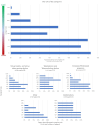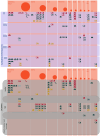The wide world of technological telerehabilitation for pediatric neurologic and neurodevelopmental disorders - a systematic review
- PMID: 38694988
- PMCID: PMC11061864
- DOI: 10.3389/fpubh.2024.1295273
The wide world of technological telerehabilitation for pediatric neurologic and neurodevelopmental disorders - a systematic review
Abstract
Introduction: The use of Information and Communication Technology (ICT) for assessing and treating cognitive and motor disorders is promoting home-based telerehabilitation. This approach involves ongoing monitoring within a motivating context to help patients generalize their skills. It can also reduce healthcare costs and geographic barriers by minimizing hospitalization. This systematic review focuses on investigating key aspects of telerehabilitation protocols for children with neurodevelopmental or neurological disorders, including technology used, outcomes, caregiver involvement, and dosage, to guide clinical practice and future research.
Method: This systematic review adhered to PRISMA guidelines and was registered in PROSPERO. The PICO framework was followed to define the search strategy for technology-based telerehabilitation interventions targeting the pediatric population (aged 0-18) with neurological or neurodevelopmental disorders. The search encompassed Medline/PubMed, EMBASE, and Web of Science databases. Independent reviewers were responsible for selecting relevant papers and extracting data, while data harmonization and analysis were conducted centrally.
Results: A heterogeneous and evolving situation emerged from our data. Our findings reported that most of the technologies adopted for telerehabilitation are commercial devices; however, research prototypes and clinical software were also employed with a high potential for personalization and treatment efficacy. The efficacy of these protocols on health or health-related domains was also explored by categorizing the outcome measures according to the International Classification of Functioning, Disability, and Health (ICF). Most studies targeted motor and neuropsychological functions, while only a minority of papers explored language or multi-domain protocols. Finally, although caregivers were rarely the direct target of intervention, their role was diffusely highlighted as a critical element of the home-based rehabilitation setting.
Discussion: This systematic review offers insights into the integration of technological devices into telerehabilitation programs for pediatric neurologic and neurodevelopmental disorders. It highlights factors contributing to the effectiveness of these interventions and suggests the need for further development, particularly in creating dynamic and multi-domain rehabilitation protocols. Additionally, it emphasizes the importance of promoting home-based and family-centered care, which could involve caregivers more actively in the treatment, potentially leading to improved clinical outcomes for children with neurological or neurodevelopmental conditions.
Systematic review registration: PROSPERO (CRD42020210663).
Keywords: children; home-based; neurodevelopmental disorders; neurological disorders; pediatric; technologies; telerehabilitation.
Copyright © 2024 Del Lucchese, Parravicini, Filogna, Mangani, Beani, Di Lieto, Bardoni, Bertamino, Papini, Tacchino, Fedeli, Cioni, Sgandurra and the Italian Neuroscience and Neurorehabilitation Network.
Conflict of interest statement
The authors declare that the research was conducted in the absence of any commercial or financial relationships that could be construed as a potential conflict of interest. The author(s) declared that they were an editorial board member of Frontiers, at the time of submission. This had no impact on the peer review process and the final decision.
Figures






 , Virtual reality and active video gaming devices;
, Virtual reality and active video gaming devices;  , Telemedicine and Telemonitoring devices;
, Telemedicine and Telemonitoring devices;  Computer-based program;
Computer-based program;  , Web-based platform;
, Web-based platform;  , other devices.
, other devices.References
-
- World Health Organization . Global diffusion of eHealth: Making universal health coverage achievable: Report of the third global survey on eHealth. Geneva: World Health Organization; (2016). 156 p.
-
- Conti E, Sgandurra G, De Nicola G, Biagioni T, Boldrini S, Bonaventura E, et al. . Behavioural and emotional changes during COVID-19 lockdown in an Italian Paediatric population with neurologic and psychiatric disorders. Brain Sci (2020) 10:918. doi: 10.3390/brainsci10120918, PMID: - DOI - PMC - PubMed
Publication types
MeSH terms
LinkOut - more resources
Full Text Sources
Medical

